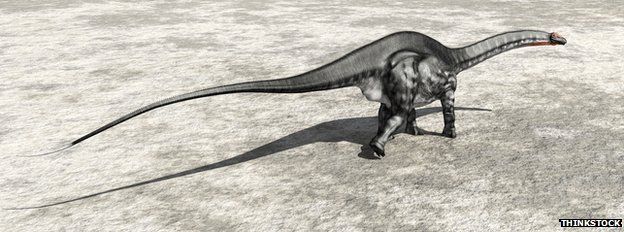Dinosaurs 'neither warm nor cold blooded'
- Published

Dinosaurs fit in an intermediate class between warm and cold blooded animals, a study in the journal Science claims.
Scientists compared the growth rates of hundreds of living and extinct species, using growth rings and bone size to calculate the rates for dinosaurs.
They linked growth rate to metabolic rate, the measure of energy use that divides warm and cold blooded animals.
The study suggests that the dinosaurs fall into a middle category, in a fresh contribution to an enduring debate.
Warm blooded animals, like mammals and birds, need a lot of fuel and use that energy to their advantage, including faster movement and boosted brain power. In burning all that food they also maintain a high, stable body temperature.
Cold blooded animals are more economical, but lack those advantages.
"If I were eating sandwiches all day... I might have to eat five," explained John Grady, the study's first author and a PhD student at the University of New Mexico. "But a reptile [my size] can eat maybe a couple of sandwiches in a whole week."
Scientists define these different strategies as "endothermy" (endo for inside; therm for heat) and "ectothermy".
The question of which biological system underpinned the lumbering success of the dinosaurs is arguably "the last big one", Mr Grady told the BBC - following other big debates over their extinction and their relationship to birds.
His paper proposes that dinosaurs may have used a not-too-hot, not-too-cold approach: "mesothermy".
The evidence for this idea comes from a big survey of the growth rates in 381 different species, including 21 dinosaurs. Because bones show growth rings much like trees, the size of fossilised dinosaur bones at different ages allows palaeontologists to calculate how fast they put on weight over a lifetime.
Information from the hundreds of living species showed that metabolic rate - the sandwich factor - is higher in animals that grow faster.
"If you double your metabolic rate, you roughly double your growth rate," Mr Grady said.
So he and his colleagues took growth rate as an indicator of metabolism, and found that dinosaurs occupied a middle ground, somewhere in between modern reptiles and mammals.
Their results also place several living animals with unusual energy habits into the proposed mesothermic category.
Tuna, some sharks, and the leatherback turtle, for example, generate more heat than other fish and reptiles, while the echidna, Australia's spiny egg-laying mammal, shows an un-mammalian inability to maintain a constant body temperature.
'Problematic' or 'unsurprising'?
The idea that dinosaurs fit poorly into existing categories is not entirely new. In a study published in February, researchers from the University of Mainz placed dinosaurs in the middle of their own growth-rate survey.
"Personally I don't find the result very surprising," commented Dr Paul Barrett from the Natural History Museum in London. But he was impressed that the new paper had convincingly added metabolic rates to the picture.
"It's nice that they've taken real, empirical data from living animals and come up with a model," he told BBC News. "There's always been some discussion over whether you can use growth rate as a proxy for metabolic rate. What this shows is that maybe we can have more confidence."
"They've brought a lot of data together and make a nice case," Dr Barrett said.
Creating a whole new mesothermic category, something also discussed by Canadian palaeontologist Dr Scott Sampson in a 2009 book chapter called "The Goldilocks Hypothesis", seems to split opinion.
"Mesothermy I see as a little bit problematic," offered Dr Jan Werner, lead author of the Mainz study. He is uncertain about the mixing of classical endotherms and ectotherms within an additional group.
"I'm not sure if this is a useful or necessary category," Dr Werner said. But he agrees that the existing system is too simplistic, saying a dichotomy of endotherms and ectotherms is "too easy".
"It's basically a spectrum," observed Dr Barrett. "I don't think it's bad to have a new word that describes animals that are in the middle of that spectrum."
This also appeals to Prof Mike Benton, an eminent palaeontologist from the University of Bristol. "It's a neat term for a few, perhaps odd, living forms, and for dinosaurs as a whole," he told the BBC.
"It reminds us that living organisms don't always show the only or best adaptations; dinosaurs did something else and what they did had many advantages - they could achieve the benefits of stable, warm body temperatures without having to eat so much."
Other experts, however, will take more convincing that dinosaurs sat on the fence, metabolism-wise.
"They could find only eight species living today that are mesotherms," said Prof Roger Seymour, a reptile physiologist at the University of Adelaide in Australia. "Doesn't that suggest that there's an adaptive value in being either a good ectotherm or a good endotherm, but not in the middle?"
Prof Seymour has argued since the 1970s that dinosaurs were warm-blooded. He points to the large blood vessel tracks found in dinosaur bones, and other evidence suggestive of high blood pressure and a big, warm blood supply.
"It would be disadvantageous to be in the middle," Prof Seymour told BBC News. He remains convinced that only powerful, genuinely endothermic dinosaurs would have wielded sufficient energy to remain dominant for 150 million years.
"You have to realise that this group of dinosaur physiologists, including me, are very hesitant to change our minds. Each one of us has the smoking gun, we think, that proves one thing or another."
And so the debate goes on. Mr Grady seems pleased to have made a splash as a graduate student.
He chuckled: "It's a good start. Maybe I'll get a job!" And he added: "It's been an exciting week."
- Published27 June 2012
- Published17 May 2014
- Published7 May 2014
- Published11 July 2006